Airships are not peaceful sky
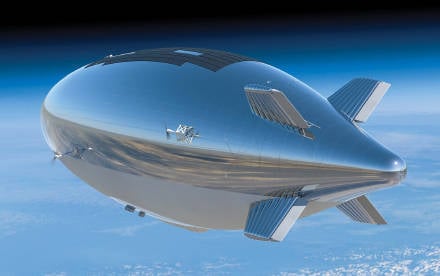
“Zeppelin” ... In the years of the First World War, the mere uttering of this word was capable of terrorizing the inhabitants of Great Britain, France and the Benelux countries. The huge airships of rigid construction, created by the German genius Count Ferdinand von Zeppelin, literally terrorized the military, but especially - residents of large European cities, subjected to night raids of German air giants. "The murderer of children" - so called the British creation of Count von Zeppelin. Although after the war, passenger airships were very popular and comfortable means of transportation. Remember one of the films about Indiana Jones, where the hero and his father flee from the Third Reich exactly on the dirigible?
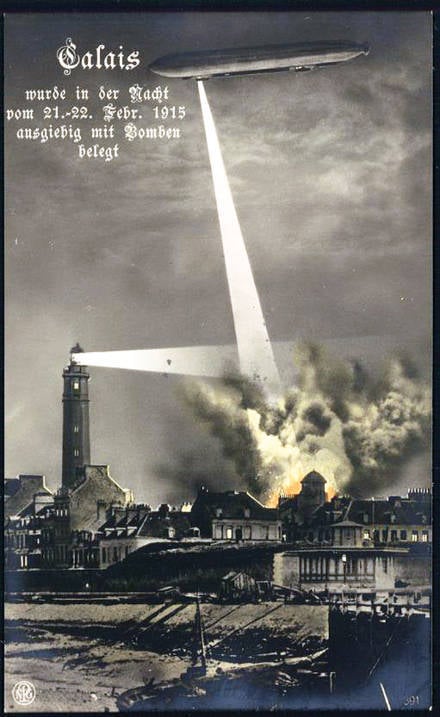
During the First World War, the German zeppelins terrified the enemy, especially the inhabitants of large European cities.
During the Second World War, combat airships gave way to unmanned aerostat barriers, creating at least some obstacle to armadas of enemy bombers. Then, for many years, airships became the subject of sports and private entertainment interest, but recently they have again fallen into the field of view of the military from a number of countries around the world, but already as inexpensive and highly effective means of observation, reconnaissance and retransmission of data.
TV scouts
One of the first idea of the military use of airships reanimated the US military. In particular, the US ground forces initiated a program for developing a long-duration multi-purpose reconnaissance vehicle LEMV (Long-Endurance Multi-Intelligence Vehicle), the contractor for which was Northrop Grumman, which proposed a design of an aircraft of a combined design and large dimension.
The device, which received the working designation LEMV, constructively represented a multi-balloon airship of a combined design with a soft shell with a total volume of 1340 thousand cubic meters. ft (37,9 thousand cubic meters), filled with helium and having aerodynamic surfaces (horizontal and vertical). This design made it possible to combine the positive advantages of the aircraft and the airship: during takeoff and climb, the lift force by about 40% is provided by aerodynamics (the “flat” airship body and wing), while at high altitude the bulky sheath enters apparatus "afloat". It should be noted that the shell of the airship is made using such special materials as Vectran, Kevlar and Mylar, which, according to the developers, allow the shell to withstand direct hits weapons.
The airship also has a gondola with various target equipment and auxiliary equipment (the gondola is three-sectional, includes a flight deck with a payload compartment, a middle part with a universal cargo winch for load suspension, as well as a stern compartment in which fuel tanks are placed), as well as propulsion consisting of four diesel eight-cylinder engines with a capacity of 340 l. with., placed together with three-bladed propellers in rotary installations and providing take-off and landing apparatus, as well as its movement in flight. To improve handling at low flight speeds, an auxiliary propeller is installed in the annular attachment in the upper nose of the airship. The platform itself - the airship of the brand HAV 304 (HAV from the "hybrid air vehicle") - was developed by the British company Hybrid Air Vehicles Ltd., a subcontractor for the project, based on its earlier model, the airship SkyCat. Representatives of the British company indicated that in 2002, they conducted a demonstration of their prototype - an airship length of 50 feet (15,2 m) - the delegation of the US Department of Defense and the Americans were pleased with it. Later this resulted in a contract for the LEMV program.
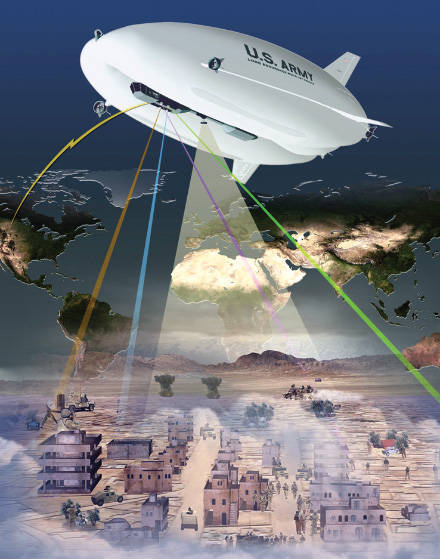
The maximum length of the airship is 300 feet (91,4 m), width is 113 feet (34,4 m), and height is 85 feet (25,9 m). The device must fly at a height of up to 22000 feet (6096 m) with a duration of at least 21 days and be able to reach maximum flight speed of 80 nodes (about 148 km / h) and carry out long patrols with a cruising speed of 30 nodes (55,6 km / h). The range of the airship should have been at least 3000 km, the fuel supply was about 13250 liters, and the flight hour of operation should have been within 10 – 20 thousand dollars.
"LEMV will be the best in terms of the duration of the flight of an unmanned aircraft in the world, which will allow you to avoid interruptions to intelligence data coming to consumers on the battlefield," the vice president of Northrop Grumman and the program director emphasized in an interview with The Engineer magazine. in the field of airships Alan Metzger. Moreover, according to the company's experts, one LEMV complex could, if it entered the arsenal, could replace medium-manned reconnaissance planes in the designated area of operations up to 25, thus significantly reducing the customer's operating costs.
The LEMV payload, the maximum mass of which reaches 2750 pounds (approx. 1250 kg), may include a radar station, optical-electronic and radio-electronic reconnaissance systems, infrared search equipment, radio-electronic equipment, radio relay equipment, etc. And the on-board system is based on the principle of "open architecture" and allows you quite easily and quickly - almost like the computer principle of "plug and play" - to include in the onboard target load various equipment. The power supply of the onboard equipment is from current sources, which, according to the tactical and technical requirements, were supposed to produce up to 16 kW of electricity.
Management aviation the complex and its target load is provided by operators using the universal ground control station (Universal Ground Control Station), adopted by the U.S. Army and used to control various types of army unmanned aerial vehicles. Moreover, unlike its counterparts, LEMV is not a completely unmanned, but an optionally manned aircraft complex. The manned version is supposed to be used when performing long-haul flights to areas of future operations, as well as in case of use in the cargo version - for transportation of goods. According to Northrop Grumman, the airship can transport 7 tons of cargo at a speed of 30 knots (about 55,6 km / h) over a distance of about 4400 km. In the manned version, only one pilot is required, and a group of 18 airships in the theater area remote from the main base is provided by a group of specialists consisting of 12-24 people.
The LEMV program was transferred to the US Space Forces and Missile Defense Command Directorate, which 14 on June 2010 issued to Northrop Grumman a contract worth 517 million dollars to develop and build one prospective aircraft prototype, with an option to build two more prototypes. The cost of one prototype was estimated at about 154 million dollars. In addition to the mentioned “Hybrid Air Vehicles Ltd.”, the number of contractors included US companies “Warwick Mills” (design and production of materials for the airship shell), “ILC Dover” (production of the airship construction), “AAI Corp.” (a division of Textron ; control and data exchange systems for manned and unmanned reconnaissance aviation of the US Army) and SAIC (issues of obtaining and processing intelligence video). In total, the project team included experts from US 18 states and from three foreign countries.
"This project allows us to strengthen our positions in the field of unmanned aircraft systems and systems of the C4 ISR class (Command, Control, Communications, Computers, Intelligence, Surveillance and Reconnaissance - command, control, communications, computers, reconnaissance, surveillance and reconnaissance), and also provides "Northrop Grumman" is an opportunity to enter the rapidly growing market of airships designed to solve military tasks and tasks in the field of ensuring the internal security of the state, "said Gary, head of the Northrop Grumman aerospace division Erwin (Gary Ervin).
“LEMV is longer than a football field, it is above a seven-story building and can stay in the air for more than three weeks, demonstrating high fuel efficiency — on the order of 11000 dollars per week of flight,” noted Alan Metzer, already mentioned. However, not everything is as rosy as the representatives of development companies represented. The disadvantages of LEMV include the need for a runway with a length of at least 1000 feet (about 300 m), as well as a “parking” space with a radius of 300 feet (about 91,5 m). These circumstances do not allow, as you can understand, to freely operate such airships on a number of military bases that do not meet the above requirements.
In November, 2010 of the year the development company completed the preliminary assessment of the project, and at the beginning of 2011 of the year completed the final design stage of the project, after which the British company Hybrid Air Vehicles Ltd. delivered all of the propulsion elements to the US, fuel tanks and the gondola, while Northrop Grumman with American subcontractors carried out the shell production and integration on board the target load. By the spring of 2011, she had to complete all the work and by November of the same year to transfer LEMV to the Yuma Proving Ground army training ground. In case of successful completion of tests, the first prototype at the beginning of 2012 was planned to be sent to Afghanistan for testing in a combat situation (the contract specified the date of shipment - 18 months starting in June of 2010). In the event that the Afghan trip would have ended without comment, it was supposed to order up to five more airships of this type.
However, violations in the approved work schedule did not allow these actions to be completed as planned, therefore, in October 2011, the authoritative British aerospace magazine Flight International informed readers that the first LEMV flight would take place only in November 2011. As a result, however, the first flight of the airship took place only on 7 August 2012 of the year - on the territory of the American joint base McGire - Dix - Lakehurst, its duration was a little more than 90 minutes (the date 7 of August is indicated in the official press release of Hybrid Air Vehicles Ltd. ”, while in the American media another date is indicated (August 8).
It is noteworthy that Lakehurst is the site of the famous Hindenburg passenger airship disaster that occurred on 6 on May 1937 on the territory of the main aeronautical base of the US Navy, which cost 35 97 people aboard and had a huge response in the world press, which was one of the reasons the termination of the mass use of airships for the transport of passengers and cargo. Thus, the Americans and the British probably sought, among other things, to demonstrate the safety of their offspring.
“A team of specialists from the USA CB and Northrop Grumman did an excellent job demonstrating the high quality of the work and mutual understanding,” Alan Metzer noted in this connection. “This platform will create new standards in the field of the duration of reconnaissance, observation and reconnaissance in the theater of operations.”
The first flight was followed by testing and refinement of the apparatus, but work on the LEMV was rather difficult, and here the reductions in the military budget of the US Armed Forces also arrived. As a result of 14 February, 2013, the US Army Command, through the mouth of its spokesman Dow Schwartz, announced that “due to technical problems and limited resources”, the LEMV program closes (for example, the 2012 was not enough for the 21,3 fiscal year million dollars). On the other hand, a few days after that, the representative of the US Army Space and Missile Defense Command, John Cummings, told reporters that “the US Army Department did not notify the US Army Space and Missile Defense Command of any changes in the status of the LEMV program and we continue to work on a technology demonstrator. ” However, the program still seems to be closed - at least while the budget cuts for the Pentagon are in effect. In total, during the tests of the prototype was supposed to make 33 flight total duration of 500 hours.
It is noteworthy that the work on this topic was started by the US Army a few years before the opening of the LEMV project. For example, in 2005, the Army Space and Missile Defense Command financed the HiSentinel project (High Altitude Guard), in which a team of Aerostar and the Southwestern Research Institute performed a small stratospheric balloon with a payload of 60 pounds (27,2 kg) to an altitude of 74000 ft (about 22,5 km).
In addition, in 2008, the US Space Forces and Anti-Ballistic Missile Command took over the high-altitude airship project (HAA - High-Altitude Airship), which had previously been launched by the Missile Defense Agency. As part of this program, Lockheed Martin’s Defense and Intelligence Systems division was selected as the main contractor, who developed the design of the device and built its large-scale prototype, which received the symbol HALE-D from High-Altitude Long Endurance - Demonstrator long flight time). The program provides for the creation of a high-altitude reconnaissance aviation complex based on a soft-construction airship of length 240 feet (73,1 m) and a working volume of the shell 500 thousand cubic meters. ft (14,16 thous. cubic meters).
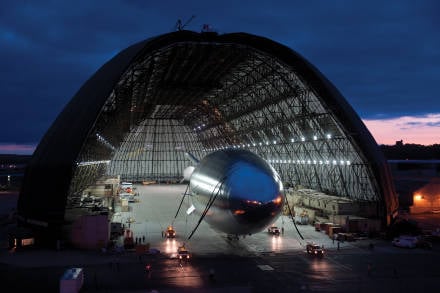
According to specialists, HALE-D should be able to patrol at an altitude of 60000 feet (about 18,3 km) for at least two weeks, ensuring the generation of electrical energy up to 500 W, which is necessary mainly to ensure the performance of the onboard communication system, which weighs on the order of 50 pounds (22,7 kg). At this altitude, the airship could control the land area with a radius of 300 miles (approx. 483 km), as well as the airspace above it. However, in a more distant future, it was envisaged to ensure multi-month patrolling, “hovering” in a given area at altitudes up to 65000 feet (about 19,8 km), as well as changing the patrolling area in the event of a change in the current situation. The device is equipped with two 2 kW electric motors, the operation of which is provided by solar panels with ultrathin panels and lithium-ion batteries. Lifting and landing of the device, as well as changing and holding positions are carried out with the help of engines.
The first flight of the prototype took place on 27 July 2011 of the year in Akron, Ohio, where the production facilities of the Lockheed Martin Defense and Surveillance Systems division and the airship dock for airships are located. However, in the first flight, the airship "made a blunder" - could not get the required height in 60000 feet (approx. 18300 m). The reason was that approximately in the middle of the way - at a height of 32000 feet (approx. 9750 m) - a technical failure occurred, forcing the developer to stop the test and immediately give the command to land. The “geostationary” hope of the US Air Force made an emergency landing in a wooded array in the southwestern part of the state of Pennsylvania.
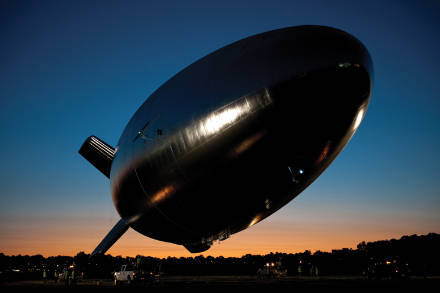
“Despite the fact that we did not succeed in reaching the planned height, we were able to test the performance of such systems as a communications complex, a remote control system, a unique propulsion unit and a power system based on solar panels, and also worked out the technology for evacuating the device from a remote, sparsely populated area” - said Dan Schultz, vice president of Lockheed Martin for ship and aviation systems. It is good that there were no victims and destructions.
Soon after such a fiasco, other technical problems emerged, so the future of this program is not yet clear. However, the company successfully continues to work in the field of airship and aerostat design for military needs. In particular, we can mention the so-called "Continuous Threat Detection System" (Persistent Threat Detection System or PTDS), developed by order of the US Army, adopted for use in 2004 year and received baptism in Afghanistan and Iraq. The system was created on the basis of tethered balloons, equipped with a wide range of detection tools and allowing for a long time to conduct round-the-clock observation of the ground and air situation in a given area. In addition, these balloons are used simultaneously and as repeaters of signals of protected radio links.
"Devil" did not get to the service
Of course, if the American army began to invest funds in projects to create reconnaissance airships, then this topic could not be left out of the attention of the US Air Force command. The latter eventually launched its own project “Blue Devil 2”, which can be translated as “Blue Devil 2”, and the serial number “2” was taken due to the fact that the number “Blue Devil 1” already included the project of converting to reconnaissance of one of the commercial aircraft.
As part of this project, the US Air Force signed a contract worth $ 6 million with a fairly young company Mav86,2, according to which the company, headed by the way, was at the time former US Air Force Deputy Commander for Intelligence, Surveillance and Reconnaissance Lieutenant-General the resignation of Dave Deptula, she pledged to carry out the development (by subcontracting - TCOM) for the aforementioned amount, building a prototype and integrating on board the corresponding target equipment - radar synthesized beam aperture and multipurpose radar, day and night vision cameras, electronic intelligence equipment, radio communication systems, retransmission and data exchange, etc. Subsequently, the program budget allocated to contracting companies increased to 211 million dollars, and even modules appeared in the payload list weapons.
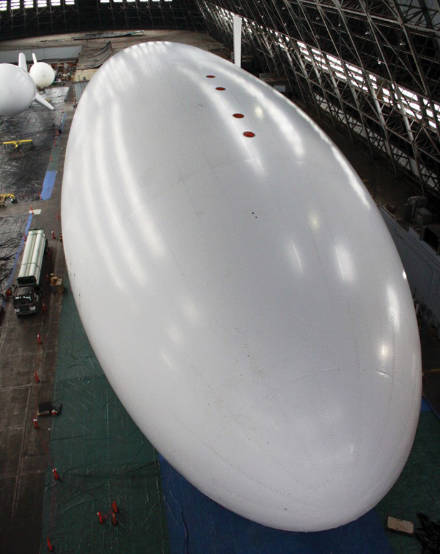
As the base part of the complex - the platform itself - it was decided to use the airship type "Polar 1000" (Polar 1000) of the company "TSOM", which had the following characteristics: maximum length - 370 feet (112,78 m), working volume - 1400 thousand cubic meters. ft (39,2 thous. cubic meters), and flight altitude - 20000 ft (6096 m). At the request of the customer, the device should have the ability to remain at a specified height for at least one week. As part of the Blue Devil 2 complex, the airship received the designation MA1400, and its energy supply system, as stated, should have a capacity of up to 120 kVA (kilovolt-amperes).
“This airship is the largest since 1960's,” noted Dave Bithner, vice president of business development at Mav6. No wonder - after all, he had to keep under control a huge area of 64 square. km
According to the plan approved by the customer, the construction of the first prototype of the “Blue Devil” was to be completed in September 2011 of the year, October 15 of the 2011 had to be lifted for the first time, and in 2012 the device was supposed to take part in trials in combat conditions on the territory of Afghanistan. However, during the development, numerous technical problems emerged, caused, among other things, by errors in design and the inability of subcontractors to meet the specified weights. In particular, the tail assembly mass was significantly higher than the calculated, and in the work of a number of onboard systems — from the electronic weapons — serious failures were found (for example, the Argus camera could not be integrated into the joint work with other sensors) a camera that was able to “cover” only 4 sq. km - instead of the planned 64 sq. km.
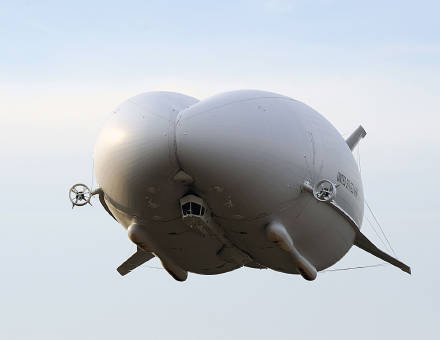
As a result of all this, the developer postponed the first flight to April 15, 2012, and the US Air Force experts, to their surprise, discovered as a result of special calculations that their promising aviation complex with reduced performance for some reason costs four times more than originally expected. The verdict was inevitable - in June 2012, the US Air Force command closed the project without much noise, and the built prototype was sent to the warehouse. But at one time, the developer company stated that one MA1400 could replace as many as 39 reconnaissance "drones» aircraft type, which are today in service with the US Air Force.
DARPA enters the file
The idea of another high-altitude reconnaissance airship project, which should be mentioned in our review, belongs to the United States Defense Advanced Research Projects Agency (DARPA), which allocated more than 500 million dollars to it.
The program, designated ISIS - from Integrated Sensor Is Structure (can be translated roughly as "Structurally Integrated Sensor"), provides for the creation of a high-altitude reconnaissance aviation complex on the basis of a dirigible, into which a dual-band radar station with an active phased antenna array of a large area is integrated, the development of which entrusted to Raytheon. In the “UHF” operating range, it is planned to detect ground and surface, including mobile, targets, and in the “X” operating range, small-sized “cruise missile” or “unmanned aerial vehicle” type air targets.
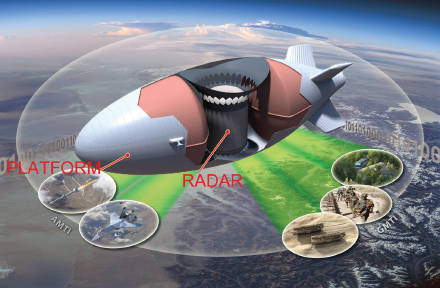
In April, DARPA under this project issued the corresponding contract to Lockheed Martin (a Skunk Works unit was involved in its work, which at one time created the stealth aircraft F-2009) and Raytheon, which turned out to be the winners in the previously announced tender (Northrop Grumman also participated in it).
“The main task of ISIS is to monitor air and ground targets and transfer the collected information directly to consumers in the combat zone,” notes Michael Wechsberg from the Raytheon Space Aviation Systems division. “At the same time, the radar complex should work without replacement up to 10 years.”
According to the calculations of Lockheed Martin specialists involved in this project, such an aviation complex, located at an altitude of about 70000 feet (about 21,3 km), will be able to detect ballistic missiles at a distance of up to 2000 km without special problems, “the most modern cruise missiles” - at a distance of 600 km, and single infantrymen, or a car hidden under the tree branches, at a distance of up to 300 km. In the case of successful implementation of this program, the US military and intelligence services are expected to be able to replace several airborne systems with ISIS airships at once, including E-3 airborne and E-XNumx airplanes. With JSTARS long-range radar detection and targeting systems. DARPA specialists, for example, stressed that the airship located “over the middle of the Luzon Strait” (the strait between Taiwan and the Philippine island of Luzon) will be able to control the territory of Taiwan, the Taiwan Strait and the adjacent strait regions of China. At the same time, the device will be able to remain in a given area “for several years”, having the ability to move to any other region of the world for no more than 8 days.
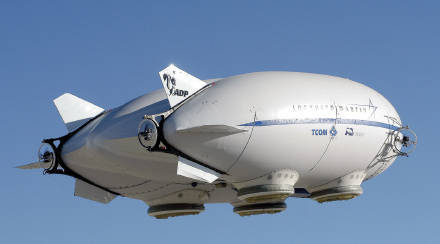
The much more “voluminous” budget of this program is explained, among other things, by the more active use of various high-tech “highlights”, which have not yet found mass application in other samples of aviation and other equipment. In particular, it was originally even supposed to structurally integrate the antenna array of the main airborne radar into the surface of the airship envelope. However, later the developers had to abandon this undertaking, however, the antenna array area still remained large - according to experts of the contracting companies, it will be about 6000 square. meters and will compensate for the relatively low power of the on-board power source “serving” the radar.
Representatives of Lockheed Martin are planning to build a large-scale prototype - one third of the basic dimensions of the device - and begin its testing in the 2013 year.
"Nautilus" of the ocean of air
Many children in childhood read out the adventures and drama of the mysterious captain Nemo and his mysterious Nautilus submarine, full of adventures and drama. However, today the Italian developers offer its unusual relative - the unmanned airship-catamaran "Nautilus", intended for operations in another ocean, the air.
The full original name of this system is ELETTRA Twin Flyers System. The developer is Nautilus, located in Turin, Italy; it is organizationally part of Selex Communications, which, in turn, is a member of the well-known Finmeccanica consortium. Therefore, this system was also assigned an unofficial, so-called "common" name - "Nautilus". It should be noted that the development of the catamaran airship was carried out with the active assistance of the specialists of the aerospace engineering department of the Polytechnic University of Turin and its subdivision in the nearby Alessandria, our sister-in-town Ryazan. In particular, specialists of the university branch in Alessandria under the leadership of Professor Paolo Ferraris (Paolo Ferraris) were engaged in the development of special water-repellent fabric for catamaran dirigible balloons, as well as individual elements of the control system and stabilization of the air apparatus, etc.
The composition of the system of intelligence and surveillance includes:
- a double-balloon unmanned airship with an electric control system, the cylinders of which are connected to a catamaran-type twin design and filled with helium (dimensions - 26 x16 x9 meters);
- ground control station;
- ground post planning tasks and monitoring its implementation (also controls the target load of the airship).
Ground stations and air "catamaran" are connected by a system of protected noise-resistant radio communications. The system of internal data exchange with the possibility of wireless connection of several external consumers allows integrating the ground stations of this system into various military command and control systems. According to developers, this system is a very attractive and low-cost model of avionics technology, capable of solving a wide range of security tasks in the border areas and over lake and sea areas. Especially - as part of an integrated system of reconnaissance, observation or monitoring, in cooperation with manned aircraft (helicopters) and unmanned aerial vehicles of various types.
One of the engineers of the development company, Piercarlo Vercesi, in an interview with the La Stampa newspaper in August 2008, in particular, noted that the Nautilus system can be used with high efficiency for solving the following tasks: “environmental and radiation monitoring, including waters of rivers, lakes and other bodies of water; control of illegal migration, smuggling of goods and drugs; search and rescue operations over land and sea; the implementation of planned, regular monitoring of gas and oil pipelines, railway stations and railways, highways and other transport facilities; to ensure counterterrorism and various police operations, as well as a means of monitoring when monitoring various public events, such as sports, and for military purposes. " In addition, this system can be successfully used as an airborne relay station - for example, during disaster management or in emergency situations, or as a trans-horizon radio station.
The airship is equipped with various target equipment (payload mass - 50 – 100 kg), which is located in the central section of the “air catamaran” and which may include:
- radar detection of air and ground (surface) targets;
- optoelectronic and hyperspectral observation systems;
- searchlight;
- equipment for measuring the level of radiation contamination;
- automatic identification system;
- two-way communication system, including satellite communications equipment and a secure (secure) communication line, and a number of other elements and subsystems.
The airship propulsion system includes the 4 horizontal motor and the 2 vertical stroke engine operating from a combined energy source - lithium-polymer rechargeable batteries and hydrogen-based fuel cells. Moreover, the horizontal stroke engines can be rotated 360 degrees. This propulsion system allows the airship to reach a maximum horizontal speed of 25 m / s (90 km / h), a cruising speed of up to 20 m / s (72 km / h) and reach a maximum vertical speed of 3,5 m / s (12,6 km / h).
According to the calculated data, the air "catamaran" is able to hang at a designated point under the following weather conditions: headwind with a maximum speed of up to 45,8 of the node (about 84 km / h) and side wind with a maximum speed of 18,7 of the node (about 34 of km / h). The maximum lifting height of the airship is 6000 meters. For the transportation of one catamaran airship, two Euro 6 class cargo-carrying containers and one such container are required for the transport of auxiliary equipment and instruments.
The development of the ground control station "Nautilus" was carried out by specialists from the Polytechnic University of Turin under the direction of M. Battipede, M. Vazzola and P. Gili.
The composition of ground stations (control and task planning) is not constant and may vary depending on the tasks and the surrounding (operational) situation.
A typical control station is equipped with a fairly simple interface for operators to learn and use. Including a mandatory condition is set to ensure the possibility of rapid development of this equipment by unprepared personnel.
A typical station (post) for planning a task and monitoring its implementation is completely different in its composition from the ground control station of the aviation complex under consideration. The main part of the equipment is the equipment for receiving, processing and visualizing data (information) collected using the entire set of target systems located in the airship gondola.
In the basic configuration, the system is served by two operators: one is at the combat position in the control station (the airship flight), and the second is at the flight task planning station. At the same time, the mobile ground station is located in a specialized car like the Russian "Gazelle", the distinguishing feature of which is a retractable "turret" - a miniature control and dispatch center for flight control of the airship. Two operators are available:
- HF / VHF / UHF radio communications equipment, satellite communications, as well as the safety equipment;
- interference suppression system;
- points of wireless connection of external consumers of information;
- equipment of those systems that are currently being included in management systems under the program of so-called “network-centric operations”.
The developer planned to build a full-scale Nautilus prototype before the end of 2007, and begin testing it at the company's air base at Reggio Emilia at the beginning of 2008. According to the representative of the developer, in 2005, the production was visited by a delegation of representatives of the US Navy, who familiarized themselves in detail with the features of the project and the capabilities of the proposed intelligence and surveillance system by the Italians.
Currently, the Nautilus air project is in the “Military and Defense Products” section of the Italian aerospace and defense company Finmeccanica, which conducts its marketing on the international military and dual-use market. However last news on the site of the developer himself, Nautilus S. pA, whose staff at the time of the active advertising company Nautilus in 2007 – 2008 was only two dozen people (another confirmation that in the West a significant part of innovative developments in the interests of the military and special services performed by small business), dated only 2010 year.
The further fate of this project is still covered with a fog of obscurity. It can be assumed that the developer simply could not find potential buyers, including due to the fact that the active phase of work on the Nautilus fell on a period of severe financial and economic crisis that broke out in the world, as well as a certain tendency to reduce budgetary defense spending which has arisen recently in a number of countries of the world. However, in the foreseeable future, the project of this “air guard” will get a second wind, since, according to experts, this complex of intelligence and observation may well find its niche and will be able to attract interest from potential customers, because it has several advantages compared to other existing today at the disposal of military means designed to conduct various types of reconnaissance and surveillance.
As there is no agreement
However, not all experts are so sure of the attractiveness for military needs of aircraft complexes based on airships, including high-altitude reconnaissance. In particular, an analyst in the field of unmanned aircraft and aeronautical equipment, and earlier - an officer of the US Air Force - Ed Herlik (Ed Herlik) emphasized in the 2011 year: “These devices are vulnerable to fire from the ground. After all, their declared working altitude is 20000 feet (6096 m) above sea level, and the main objects of interest (in Afghanistan. - Approx. V. Sh.) Are at altitudes greater than 10000 feet (3048 m). In addition, the mountainous terrain will significantly reduce the effectiveness of the use of their target equipment. "
The main issues surrounding the process of creating high-altitude (stratospheric) aircraft complexes based on airships can be defined as follows:
- the need to create propulsion plants, characterized by a sufficiently large capacity and relatively low mass;
- the need for solar and rechargeable batteries with appropriate characteristics;
- the need to create high-strength water-repellent materials for the shell of airships that can also withstand for a long time the powerful solar radiation characteristic of the heights at which these aviation complexes are supposed to be used.
In October 2012, the Court of Auditors of the United States released the results of a study (report “Future Aerostat and Airship Investment Decisions Drive Oversight and Coordination Needs”), conducted on 15 of the main programs of aerostat and airship construction, carried out or implemented since 2007 in the interests of the military - fully or “mainly” (today three large “balloon-airship” programs are in the implementation stage). The reason for this study was the fact that the Pentagon’s expenditures on this topic became “substantially large” and made up almost 2007 billion dollars in the fiscal year from 2012 to 7! In particular, 2012 billion were allocated for this purpose only in the military budget for the 1,3 fiscal year. The findings of the report indicate, for example, that the leadership of the US DOD is not actively and clearly reporting the consolidated information on its programs in the field of aerostat and dirigible building, which does not allow, among other things, to focus the main efforts and financial resources on programs important for national security.
In conclusion, it should be noted that recently the issue of creating communication systems based on several high-altitude airships located in the stratosphere and integrated into a single system through a dedicated satellite, as well as built on the ground (surface) and the air situation in large areas (water areas). In particular, according to specialists, located at an altitude of about 70000 feet (about 21,3 km), the airship will be able to carry out continuous observation in a geostationary "orbit" in an area up to 600 miles (km) in diameter.
According to experts of the analytical company Market Intel Group, published in 2011 year (that is, after the acute phase of the global financial and economic crisis), the global demand for high-altitude (stratospheric) unmanned aerial systems of long duration of flight, including those created on the basis of airships, in terms of value is about 250 billion dollars. At the same time, the military segment of devices of a similar class in terms of value is only 2 billion dollars. The potential, as we see, is very high, so it is not surprising that a number of foreign companies have begun work on creating aviation complexes based on military, dual-purpose and commercial airships on their own initiative. It is quite possible that the era of the Zeppelin will recur in the foreseeable future.
Information